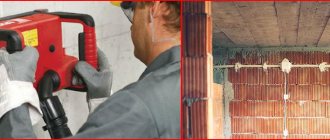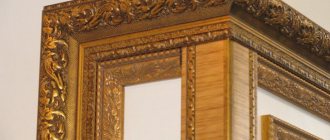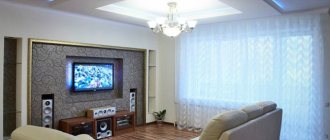Hiding wires in the wall
At the renovation stage, you can hide the wires from the TV in the wall. To do this, you need to accurately determine the permanent place of “residence” for the television panel.
Next, starting from the intended location of the wire, make a channel in the wall towards the electrical point and lay the cable. Use special construction staples to securely fix it, and then carefully cover it with plaster. Now you can start finishing work.
This method has one significant drawback - the television panel loses its mobility. If you need to move it to another location or send it in for repairs, removing the wire will be very problematic.
Keep all the necessary wires at hand
We can’t hide all the cables in a box: we need some of them almost constantly. The solution is simple: secure them to the edge of your desktop so that if necessary, you can reach out and connect the device to the desired wire. Sugru will help us with this - plasticine-rubber and one of the most irreplaceable things in the household. Don't believe me? Then watch our video.
Roll Sugru into small balls and secure them to a table support. Then use a utility knife to remove some of the plasticine (be careful, try not to deform the balls too much). Life hack: to prevent the plasticine from sticking to the blade, first rinse it with soapy water. Then adjust the shape a little with a sushi stick or toothpick to create neat hollows (they should be slightly wider than your wires). Everything is ready, you can fix the cables.
instructables.com
instructables.com
instructables.com
instructables.com
instructables.com
There is an option for those who know how to work with wood. A small block with holes will help organize all the wires on your desktop.
instructables.com
instructables.com
instructables.com
The simplest solution is to pass the wires through binders attached to the tabletop.
hexjam.com
Masking with a cable channel
Use a camouflage box. With its help you will hide television wires without disturbing the surface of the wall. This structure is fastened with hidden screws and liquid nails.
Today you can purchase a cable channel model that best suits the style of the room. The simplest type is an ordinary plastic box, which after installation can be covered with the same finishing material as the entire wall.
There are models lined with decorative bricks or in the form of pipes, which are ideal for interiors in loft and hi-tech styles. For classic or eco-trends, you can choose wooden or MDF models.
Important nuances when working with TV wires
Television is supplied to the apartment via cables. Various cords also come from the equipment itself, and along them there is electricity, which requires compliance with safety precautions:
- Before starting electrical wiring, it is necessary to de-energize the room. In general, this is done by people with permission to carry out such work - electricians. Without experience and knowledge, it is better not to do anything yourself;
- before working with cords, they are disconnected from the network;
- If you want to decorate a wire, you need to make sure that its sheath is intact and without damage.
To make the equipment last longer, the cords are placed loosely, but not tightly.
It would seem like a minor issue - cables on the wall, but how do they affect the integrity of the interior. The article describes several ways to mask communications, both simple cords, for example, HDMI, and antennas. If necessary, use your imagination and create original decor from familiar things.
Hiding behind drywall
Drywall is widely used in the design of modern interiors, as it allows you to mask surface imperfections and create original decorative designs. Why not take advantage of this?
Come up with a wall structure, for example, in the form of a plasterboard box with niches, shelves and, of course, space for a television panel. After installation, all wires will be securely hidden, and the interior of the room will become more stylish and functional.
You can build a false fireplace from drywall and install a TV above it. This way you will get a great seating area, and the wires will be securely hidden.
Options for laying wires without gating
Often, new equipment is connected, leaving the wires lying on the floor or hanging on the walls. It looks unsightly, spoils the interior, and, moreover, creates the danger of equipment falling or a person tripping over scattered wires.
If a major renovation is being done in the house, then all the wires are laid in the walls - in grooves. If the house is wooden, the wires are usually hidden in protective corrugated sleeves. You can place the wires on one of the “edges” of the room - on the walls, floor or ceiling. Let's take a closer look at these options.
Floor
Sometimes you need to run wiring across the floor. This is easier to do than on the walls. If the installation is carried out after repairs, naturally no one will want to cut grooves in the cement screed. We need to look for more affordable installation methods.
The best option for laying wires on the floor without gating:
- In special skirting boards with holes. Construction stores offer a wide range of similar products. The wires are laid in the plinth, removing the removable element. After installation, the “valve” is returned to its place.
- Under laminate. To implement this option, the lamellas under which the cable will be passed are partially removed - right up to the construction joists. The wire is laid in a corrugated pipe. If necessary, space is cut into the wood for the wires to cross.
Ceiling
The choice of installation option on the ceiling depends on the type of ceiling covering. Stretch ceilings are often installed in residential premises and offices. They “eat up” excess space, but allow you to distribute them at the top as required by the electrical supply diagram.
There are no obstacles for cables on the ceiling and they can be laid there along the shortest path, this allows:
- reduce costs;
- reduce work completion time;
- reduce the overall circuit resistance;
- ensure a higher level of fire safety;
- if necessary, it is easy to replace the wires.
According to fire safety requirements, cables must be covered with corrugated pipes. The same should be done with wiring installed behind suspended ceilings, in niches or plasterboard structures.
It is recommended to connect all the wires into one trunk - this will simplify future repair work. If the ceilings are concrete, you can’t do without gating.
Walls
The cable on the wall can be placed in a decorative box - this option is especially good for large-diameter wires, since there is no way to hide them in the wall without repairs.
Other options for laying wires on the walls:
- hide in door frames;
- cover with baguettes or moldings;
- lay in the window slopes.
Please note that the last three options are only suitable for low-current wires (Internet, telephone, etc.). High voltage wires may be laid in accordance with fire safety standards.
How to hide wires in furniture
The TV can be installed in a wall set, which will hide all communications in its depths. But if you don’t like bulky structures, use modular elements, such as a wall cabinet.
Many modern models of such furniture already have special holes in their design into which wires are laid.
Stretch ceilings in the interior of an apartment (200 photos)
Wire panel
If you are a creative person, come up with some kind of wall drawing, the contours of which you will draw with wire. You can find quite a lot of such ideas on the Internet!
Draw a sketch on the wall with a pencil and start laying. Don’t forget that the pattern or geometric figure should fit harmoniously into the interior.
An important point is the method of fixation. Nails are not suitable for this work - they can damage the cable and spoil the design with their unaesthetic appearance. Therefore, use double-sided tape or glue.
Don't hide the wires
Seriously, if you get creative with it, cables can be an interesting decorative element.
In everyday life, situations quite often arise when the available sockets in an apartment or private house do not allow the use of any electrical appliances or household appliances. The main reason is their inconvenient location, so owners prefer to use an extension cord. In some cases, increased power outlets or a longer cord are required. In this case, home craftsmen make an extension cord with their own hands. A self-made extension cord will be much cheaper than a branded one and much more reliable. If you have the skills to work with the tool, the entire procedure takes from 15 minutes to half an hour.
Masking with vinyl stickers
Interior vinyl stickers are an excellent decorative material. Its main advantage is that it allows you to quickly transform the interior and emphasize style. At the same time, such decor can be removed or replaced with a new one at any time without any problems.
Use vinyl stickers to create decorations where the TV cable is located. It could be a branchy tree, with the crown of which the cable will blend into the color palette.
Wiring diagram
Safe wiring cannot be achieved without prior planning in the form of a work plan.
For home use, you can get by with a handwritten plan on paper. It is enough to measure the required distances with a tape measure and put them on the drawing. But to increase reliability, knowledge of electrical circuits and experience as an electrician will be required.
If you do not have the required knowledge, you can always use the services of specialists. Most often they use Elektrik 7.8 software. It greatly simplifies wiring design. There is no charge for using the program. The specialist will quickly build and calculate complex circuits thanks to a well-thought-out algorithm. Visio is also used to design the lighting circuit.
After drawing up the project, the locations of sockets and switches are marked on the walls. It is worth considering the feasibility of such a location. In practice, you often have to give up some connection points.
Wires behind a wooden panel
Installing a wooden panel with a TV will not only adequately highlight the design of the room, but will also become an excellent camouflage element that will allow you to hide the wires.
Wooden panels can have a different color palette and shape, adding sophistication and presentability to the interior. In addition, the material will serve as a good sound insulator, so you won’t have to worry about the indignation of picky neighbors who are dissatisfied with the increased volume.
60+ beautiful narrow bedroom design ideas (photos)
Techniques for conducting and hiding wiring in an apartment
The two most well-known methods of wiring in an apartment: hidden and open. The first, as stated above, involves grooved walls and ceilings.
At the same time, at the time of laying the wires in the grooves, for protection and to ensure the convenience of further work, the wiring is pulled through the corrugation. Having secured it in the recess along the entire line of the excavation, plastering work is carried out. Align the places where the corrugation is laid and then carry out the usual finishing work (putty and painting or wallpapering).
Unlike the hidden type, the open type is based on the visible distribution of wiring throughout the apartment. This method of arranging wires along surfaces can be used in the event that a certain old section of wiring is blocked or if it is necessary to carry out a specifically open form of electrical wiring.
Here, instead of corrugation, plastic electrical boxes (cable channels) of various sections are used, which are mounted on the surface of the walls vertically or horizontally. The wiring is located inside the cable.
Branches of dry and artificial plants
Wires from the TV can also be hidden using branches of artificial plants. Place a vase with dry twigs near or under the TV panel and all attention will shift to an attractive-looking composition.
You can use special wire covers in the form of branches, which are quite similar in design to cable channels, but at an aesthetic level they are much superior. Such functional decor will look great in a children's room.
Hide the extension cord with chargers in a box
The extension cord with chargers constantly gets in the way on the table or under your feet, collects a lot of dust, and also looks unaesthetic. Dealing with this problem is very simple: take a nice box, make a few holes in it and hide all the wires and cables there.
homedit.com
homedit.com
homedit.com
There are also ready-made solutions, for example Plug Hub from Quirky.
This is a box made of hard plastic with a rubberized bottom. There are three holes on top for cables, and inside there are three fasteners that can be used to wrap cords that are too long. The Plug Hub can be placed on the floor or mounted on the wall. amazon.com
Wires in “ethnic” style
If the interior of your TV room is decorated in an ethical style or you simply like to surprise with the “quirks” of the interior, take note of the option of masking wires with beads. Of course, you will need fairly large parts that will fit freely on the cable.
Pay attention to the selection of colors - you can choose plain details to match the color of the wall or contrasting ones that attract attention. White and red beads are suitable for wallpaper in warm colors, and blue, green and black - in cold colors.
Organization of hidden wiring
Before installation, you should study how to organize hidden wiring:
- External wiring in a corrugated sleeve is easily hidden by various structures: sheathing with slats, suspended ceiling, etc.
- You can make hidden wiring along the joints of the ceiling and wall or floor and wall. Then it is removed under the baseboard or molding.
- The internal wiring is laid in grooves in the wall, and then covered with mortar. Or they make electrical wiring in a screed in special boxes.
- The wiring is completely hidden during construction in special channels. This method is not suitable for self-installation.
Hiding wires with threads and ropes
Another simple way to hide TV wires is to wrap them with colored threads, ribbons or jute rope.
You can choose one of several design methods. For example, simply twist the wire or braid it with a pigtail. The color of the material should be in harmony with the surrounding environment.
Suspended ceilings: 100 design ideas (photos)
Fasteners on the back side of tabletops, tables or TV stands
As is clear from the range of devices offered, there are two ways to attach computer wires to the back of the tabletop:
- With double-sided tape. Not always reliable, but at least modelable.
- Self-tapping screws. The main thing is to use the “correct” screws, no longer than the thickness of the tabletop. As a rule, 3.5x16.
It is not always acceptable to make holes in the tabletop itself or the stiffener of the table. And it’s inconvenient if the workplace is already assembled and in its place. Therefore, a perforated screen is often used as a basis for attaching cables and power supplies.
Or a metal mesh shelf of suitable width and depth. This option is more expensive, but much stronger and more durable.
Using the same harnesses and clamps, the wires with all accessories are attached to the base. And only then, after the final “assembly” - to the back side of the tabletop or stiffener. It's much more convenient.
Use books and magazines
Even books can be good helpers in trying to hide television wires. Try to choose ones that have a neat, aesthetic appearance or with bright covers.
Books and magazines can be stacked on a table or shelf under the TV. Pick up a couple of high-end editions that will reach all the way to the television panel. Don't overdo it with the quantity - keep it small so as not to create a mess.
Useful tips
In order not to get confused when masking the wires and not to get into trouble during repairs, they must be marked in advance. This will help you immediately find the right cable later. It is better to separate low-power wiring from power wiring, without connecting it into a single bundle. Wires from the antenna and the Internet should be placed separately from others so as not to spoil the signal quality.
Cables should have the shortest possible length and the minimum number of connections: this increases their safety and reduces the risk of injury. It happens that the braid of hidden cables frays due to poor placement, so in dangerous places the wiring must be checked more often. If you need to mask wiring, you can use any ideas, especially since the range of tools and materials for decoration is now huge!
Phytostena
Installing a phytowall is a stylish solution for any modern interior. It is a large panel with “pockets” in which plants are placed. Installing a TV in such a frame has many advantages, one of which is the ability to hide the wires.
In addition to the fact that the design of the room will not be disturbed by the carelessness of a hanging cable, you will be able to enjoy watching your favorite TV shows surrounded by clean, humidified air, which is important for a city dweller!











